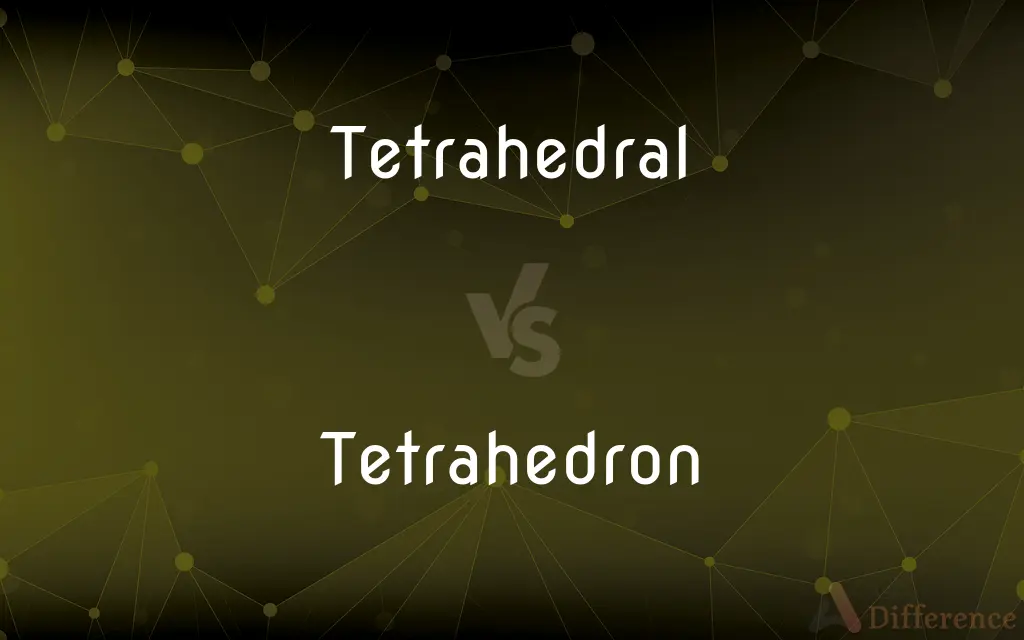Tetrahedral vs. Tetrahedron — What's the Difference?
By Urooj Arif & Fiza Rafique — Updated on March 11, 2024
Tetrahedral refers to the shape or molecular geometry, while a tetrahedron is a type of polyhedron.

Difference Between Tetrahedral and Tetrahedron
Table of Contents
ADVERTISEMENT
Key Differences
Tetrahedral describes the molecular geometry where a central atom is surrounded by four other atoms or groups of atoms at the corners of a tetrahedron. In contrast, a tetrahedron is a specific geometric solid consisting of four triangular faces, six straight edges, and four vertex corners.
While the term "tetrahedral" is often used in chemistry to describe the spatial arrangement of atoms around a central atom, such as in methane (CH4), the tetrahedron refers to the geometric figure itself, applicable in various mathematical and engineering contexts. Tetrahedral structures are not only significant in molecular geometry but also in crystal structures and coordination chemistry.
The concept of tetrahedral geometry plays a crucial role in understanding the three-dimensional shape of molecules and their chemical reactivity and properties. On the other hand, tetrahedrons are studied in geometry for their properties, such as volume, surface area, and their occurrence in natural and man-made structures.
In terms of visualization, imagining a tetrahedral molecule involves thinking about the spatial arrangement of atoms in three dimensions, where the bonds angle approximately 109.5 degrees away from each other. For a tetrahedron, the focus is on its geometric properties as a solid figure, including its symmetry and how it can be constructed or deconstructed.
The distinction between tetrahedral as an adjective and tetrahedron as a noun highlights their different but related uses: one describes a type of molecular shape based on a geometric figure, while the other is the geometric figure itself. Understanding this difference is essential for fields like chemistry, geometry, and materials science.
ADVERTISEMENT
Comparison Chart
Definition
Describes a molecular geometry or arrangement.
A type of polyhedron with four triangular faces.
Usage
In chemistry for molecular shapes.
In geometry and engineering for solid structures.
Components
A central atom with four surrounding atoms/groups.
Four faces, six edges, and four vertices.
Significance
Crucial for understanding chemical reactivity.
Studied for its geometric properties.
Visualization
Spatial arrangement in three dimensions.
Geometric properties as a solid figure.
Compare with Definitions
Tetrahedral
Helps predict molecular interactions and reactions.
Understanding the tetrahedral geometry is crucial for predicting the outcome of organic reactions.
Tetrahedron
Analyzed for its symmetry, volume, and surface area.
The volume of a tetrahedron can be calculated using its edge lengths.
Tetrahedral
Indicates the spatial arrangement affecting molecular behavior.
The tetrahedral shape of water molecules contributes to water's unique properties.
Tetrahedron
Found in architectural and molecular structures for stability.
Tetrahedral frames are used in bridges and towers for their strength.
Tetrahedral
Describes the geometry that mirrors the tetrahedron shape.
The tetrahedral molecular geometry is inspired by the shape of a tetrahedron.
Tetrahedron
Can be constructed from various materials for educational purposes.
Building a tetrahedron model helps students understand three-dimensional shapes.
Tetrahedral
Refers to a molecular geometry with a central atom surrounded by four atoms.
Methane (CH4) is an example of a molecule with a tetrahedral geometry.
Tetrahedron
Occurs in crystal and molecular structures.
The diamond crystal structure is composed of carbon atoms in a tetrahedral arrangement.
Tetrahedral
The bond angles in a tetrahedral molecule are approximately 109.5 degrees.
The tetrahedral arrangement results in bond angles that minimize electron repulsion.
Tetrahedron
A solid figure with four triangular faces, six edges, and four vertices.
A pyramid with a triangular base is a common example of a tetrahedron.
Tetrahedral
Of or relating to a tetrahedron.
Tetrahedron
In geometry, a tetrahedron (plural: tetrahedra or tetrahedrons), also known as a triangular pyramid, is a polyhedron composed of four triangular faces, six straight edges, and four vertex corners. The tetrahedron is the simplest of all the ordinary convex polyhedra and the only one that has fewer than 5 faces.The tetrahedron is the three-dimensional case of the more general concept of a Euclidean simplex, and may thus also be called a 3-simplex.
Tetrahedral
Having four faces.
Tetrahedron
A polyhedron with four faces.
Tetrahedral
In the shape of a tetrahedron
Tetrahedron
A polyhedron with four faces; the regular tetrahedron, the faces of which are equal equilateral triangles, is one of the Platonic solids.
Tetrahedral
Having four faces, four apices and six edges
Tetrahedron
A solid figure inclosed or bounded by four triangles.
Tetrahedral
Having, or composed of, four sides.
Tetrahedron
Any polyhedron having four plane faces
Tetrahedral
Having the form of the regular tetrahedron.
Common Curiosities
How does a tetrahedron differ from other polyhedra?
It has four triangular faces, distinguishing it from polyhedra with more faces or different face shapes.
Can a molecule have a tetrahedral shape with atoms other than carbon?
Yes, any central atom bonded to four surrounding groups can exhibit a tetrahedral geometry.
What is a tetrahedral molecule?
A molecule with a central atom bonded to four surrounding atoms in a geometric shape resembling a tetrahedron.
What role does tetrahedral geometry play in water's properties?
It contributes to the polarity and hydrogen bonding that result in water's unique physical properties.
Is the tetrahedral shape found in nature?
Yes, it occurs in molecular structures and crystal formations.
Are all tetrahedrons regular?
No, a regular tetrahedron has equal edge lengths and angles, but tetrahedrons can also be irregular.
How is the concept of a tetrahedron used in engineering?
Its geometric properties, especially its inherent strength, are applied in designing structures.
How do you construct a physical model of a tetrahedron?
By connecting four triangular panels along their edges to form four faces, six edges, and four vertices.
Why is the tetrahedral angle significant in chemistry?
It minimizes electron pair repulsion around the central atom, stabilizing the molecule.
What mathematical properties are unique to tetrahedrons?
The relationship between its volume, surface area, and edge lengths, especially in regular tetrahedrons.
Are tetrahedrons used in modern architecture?
Yes, for their strength and aesthetic qualities, often in trusses and other structural elements.
What is the difference between tetrahedral and trigonal planar molecules?
Tetrahedral molecules have a central atom bonded to four others in a three-dimensional shape, whereas trigonal planar molecules have three bonds arranged flatly around the central atom.
Why is understanding tetrahedral important in organic chemistry?
It aids in predicting the spatial arrangement of atoms in molecules, crucial for understanding reaction mechanisms.
Can tetrahedral arrangements be asymmetrical?
While the basic geometric shape is symmetrical, molecular tetrahedral arrangements can appear asymmetrical due to different surrounding atoms or groups.
How do tetrahedral molecules interact with light?
Their three-dimensional shape can affect how they absorb and refract light, influencing their optical properties.
Share Your Discovery

Previous Comparison
Drifter vs. Explorer
Next Comparison
Clinic vs. PolyclinicAuthor Spotlight
Written by
Urooj ArifUrooj is a skilled content writer at Ask Difference, known for her exceptional ability to simplify complex topics into engaging and informative content. With a passion for research and a flair for clear, concise writing, she consistently delivers articles that resonate with our diverse audience.
Co-written by
Fiza RafiqueFiza Rafique is a skilled content writer at AskDifference.com, where she meticulously refines and enhances written pieces. Drawing from her vast editorial expertise, Fiza ensures clarity, accuracy, and precision in every article. Passionate about language, she continually seeks to elevate the quality of content for readers worldwide.
















































